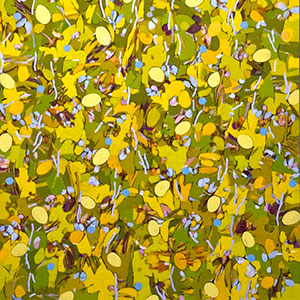

The throughline in Steve French’s oeuvrefrom the 1960s until his death in 2014can’t be defined with one approach or a singular aesthetic. He isn’t like Claude Monet (1840-1926), an artist whose recurring palette and subject matter remain instantly recognizable.
However, while looking at the San Jose Institute of Contemporary Art’s (SJICA) retrospective of his work Overture: The Art of Steve French, the exhibit confirms that you can identify French, as wellbut within a series of varying artistic strategies, from shaped prints that resemble oversized origami to industrial bronze assemblages and, of course, his paintings.
One such subset, French’s last, is very Monet-like in spirit. French took inspiration for these pieces from his garden. The signature image of the exhibit comes from this series. Yellows and greens dominate the canvas Mapping the Seasons. He’s taken the perspective of an inquisitive insect, a bee buzzing above the flowers in search of a sepaled landing place or that of an ant trudging through a forest of heavy leaves and stems. The view, although kaleidoscopic, could just be a single flower repeated as seen through the lenses of a compound-eyed bug.
Many of the paintings are there courtesy of his widow, Wanda Waldera, also an artist. She and the curators were smart to incorporate French’s notebooks into the exhibit. One of them is open to a page filled with sketches for what would become Mapping the Seasons. All the colors are confirmed, but the details aren’t. In the notebooks, we get a glimpse inside his thought process. The artist works out his ideas there on a micro level until he arrives at the finished piece. He starts with white space that slowly fills up with stones. Those ovals then reduce in size, shrinking until they recede to become seed pods, part of the garden’s overlapping abundance.
Three untitled paintings, also from 2014, take the garden as a point of departure but as seen with night vision. The abstracted shapes French paints are animal and vegetaldistended and dark green lotus pads, internal organs that bulge out in oranges, yellows and whites, or pink and red scribbled lines that suggest flowers in a state of disarray. Nothing holds its shape in this series. Each contains a black background that controls the tone and tames down the spirals, the flashing colors.
Commenting on these acrylic paintings before he died, French said, “Two subjects with cyclical themes occupy my recent work. One is the journey, a repeated cycle of beginning and end; the other is the garden with its continuing cycle of seasonal changes.” Both reflect back on each other, as day does to night. One is a journey into darkness; the other a return to vibrant life in spring.
In a companion gallery, the SJICA is honoring another aspect of French’s longtime career at San Jose State University. He began as a teacher there in 1966, retiring in 1998 as associate dean of the College of Humanities and the Arts. Encore: The Legacy of Steve French features work by the students who considered him a mentor.
A notable art teacher himself at Cabrillo College in Santa Cruz, Howard Ikemoto’s Abstraction in Grey is a riot of liquefied concrete disintegrating into watery smudges of ash. Steve Pon included West Coast Blue no. 3his bright, messy and cheerful word collage. And Katherine Huffaker Jones’ Ranch House is a playful take on a diorama, a vision of the suburbs as seen in miniature. None of the work in the Encore gallery owes a particular aesthetic debt to French. They’re not derivative or intent on imitating their former professor. What he gave them was the freedom to experiment, and to find their own authentic selves.
Overture: The Art of Steve French
Thru Feb 4, Free
San Jose Institute of Contemporary Art
sjica.org


